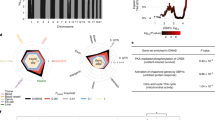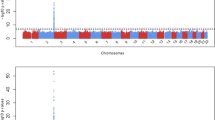Abstract
Drug-induced liver injury (DILI) is caused by unpredictable adverse drug reaction due mainly to the accumulation of hepatotoxic compounds in the liver resulting in significant damage. Drug-metabolizing enzymes have been prime targets for molecular studies relevant to DILI. The gene UGT1A9 mainly expresses in the liver and has an important role in drug metabolism. The Han Chinese has a very long and complex demographic history, and the population stratification arising from the interplay of different geographic areas may influence the polymorphism pattern. We selected 260 healthy subjects in three different geographic areas (including Xian, Shanghai and Liuzhou) for systemic screening and analysis of single-nucleotide polymorphisms (SNPs) in the promoter region of UGT1A9. Eight SNPs were identified and no regional disparity exists among the three populations. Based on these results, 213 DILI patients from all over the Chinese mainland were further recruited to investigate possible association between UGT1A9 and DILI. We observed statistically significant associations between SNP rs2741045 and DILI at both allele and genotype levels (allele: P=0.032; genotype: P=0.029; after Bonferroni correction). Also, multivariate interaction analysis discovered the interaction between rs2741045 and age associated with DILI significantly. This is the first such screening study to investigate the association between UGT1A9 promoter polymorphisms and DILI in the Chinese population and it could provide the basis for further study of DILI mechanisms.
This is a preview of subscription content, access via your institution
Access options
Subscribe to this journal
Receive 6 print issues and online access
$259.00 per year
only $43.17 per issue
Buy this article
- Purchase on Springer Link
- Instant access to full article PDF
Prices may be subject to local taxes which are calculated during checkout
Similar content being viewed by others
References
Grant LM, Rockey DC . Drug-induced liver injury. Curr Opin Gastroenterol 2012; 28: 198–202.
Suk KT, Kim DJ . Drug-induced liver injury: present and future. Clin Mol Hepatol 2012; 18: 249–257.
Vuppalanchi R, Liangpunsakul S, Chalasani N . Etiology of new-onset jaundice: how often is it caused by idiosyncratic drug-induced liver injury in the United States? Am J Gastroenterol 2007; 102: 558–562; quiz 693.
Leise MD, Poterucha JJ, Talwalkar JA . Drug-induced liver injury. Mayo Clin Proc 2014; 89: 95–106.
Russmann S, Kullak-Ublick GA, Grattagliano I . Current concepts of mechanisms in drug-induced hepatotoxicity. Curr Med Chem 2009; 16: 3041–3053.
Devarbhavi H, Dierkhising R, Kremers WK, Sandeep MS, Karanth D, Adarsh CK . Single-center experience with drug-induced liver injury from India: causes, outcome, prognosis, and predictors of mortality. Am J Gastroenterol 2010; 105: 2396–2404.
Fontana RJ, Watkins PB, Bonkovsky HL, Chalasani N, Davern T, Serrano J . Drug-induced liver injury network (DILIN) prospective study: rationale, design and conduct. Drug Saf 2009; 32: 55–68.
Russmann S, Jetter A, Kullak-Ublick GA . Pharmacogenetics of drug-induced liver injury. Hepatology 2010; 52: 748–761.
Park BK, Kitteringham NR, Maggs JL, Pirmohamed M, Williams DP . The role of metabolic activation in drug-induced hepatotoxicity. Annu Rev Pharmacol Toxicol 2005; 45: 177–202.
Lammert C, Bjornsson E, Niklasson A, Chalasani N . Oral medications with significant hepatic metabolism at higher risk for hepatic adverse events. Hepatology 2010; 51: 615–620.
Yu ML, Yang Y, Wang CM, Zhang MM, Bai MC, Guo YL . Acitretin exhibits inhibitory effects towards UDP-glucuronosyltransferase (UGT)1A9-mediated 4-methylumbelliferone (4-MU) and propofol glucuronidation reaction. Pharmazie 2013; 68: 449–452.
Court MH, Freytsis M, Wang X, Peter I, Guillemette C, Hazarika S, et al. The UDP-glucuronosyltransferase (UGT) 1A polymorphism c.2042C>G (rs8330) is associated with increased human liver acetaminophen glucuronidation, increased UGT1A exon 5a/5b splice variant mRNA ratio, and decreased risk of unintentional acetaminophen-induced acute liver failure. J Pharmacol Exp Ther 2013; 345: 297–307.
Barbier O, Girard H, Inoue Y, Duez H, Villeneuve L, Kamiya A, et al. Hepatic expression of the UGT1A9 gene is governed by hepatocyte nuclear factor 4alpha. Mol Pharmacol 2005; 67: 241–249.
Zakerska O, Skrzypczak-Zielinska M, Mikstacki A, Tamowicz B, Malengowska B, Szalata M, et al. Genotype and allele frequencies of polymorphic UGT1A9 in the Polish population. Eur J Drug Metab Pharmacokinet 2013; 38: 217–221.
Xing Y, Yang L, Wang L, Shao L, Wei Z, Xuan J, et al. Systematic screening for polymorphisms within the UGT1A6 gene in three Chinese populations and function prediction through structural modeling. Pharmacogenomics 2009; 10: 741–752.
Ikushiro S, Emi Y, Iyanagi T . Identification and analysis of drug-responsive expression of UDP-glucuronosyltransferase family 1 (UGT1) isozyme in rat hepatic microsomes using anti-peptide antibodies. Arch Biochem Biophys 1995; 324: 267–272.
Girard H, Court MH, Bernard O, Fortier LC, Villeneuve L, Hao Q, et al. Identification of common polymorphisms in the promoter of the UGT1A9 gene: evidence that UGT1A9 protein and activity levels are strongly genetically controlled in the liver. Pharmacogenetics 2004; 14: 501–515.
McGraw J, Waller D . Cytochrome P450 variations in different ethnic populations. Expert Opin Drug Metab Toxicol 2012; 8: 371–382.
Schulz C, Boeck S, Heinemann V, Stemmler HJ . UGT1A1 genotyping: a predictor of irinotecan-associated side effects and drug efficacy? Anticancer Drugs 2009; 20: 867–879.
Tang K, Li X, Xing Q, Li W, Feng G, He L, et al. Genetic polymorphism analysis of cytochrome P4502E1 (CYP2E1) in Chinese Han populations from four different geographic areas of Mainland China. Genomics 2010; 95: 224–229.
Wu Z, Zhang X, Shen L, Xiong Y, Wu X, Huo R, et al. A systematically combined genotype and functional combination analysis of CYP2E1, CYP2D6, CYP2C9, CYP2C19 in different geographic areas of mainland China—a basis for personalized therapy. PLoS One 2013; 8: e71934.
Qin S, Shen L, Zhang A, Xie J, Shen W, Chen L, et al. Systematic polymorphism analysis of the CYP2D6 gene in four different geographical Han populations in mainland China. Genomics 2008; 92: 152–158.
Chen L, Qin S, Xie J, Tang J, Yang L, Shen W, et al. Genetic polymorphism analysis of CYP2C19 in Chinese Han populations from different geographic areas of mainland China. Pharmacogenomics 2008; 9: 691–702.
Hahn LW, Ritchie MD, Moore JH . Multifactor dimensionality reduction software for detecting gene-gene and gene-environment interactions. Bioinformatics 2003; 19: 376–382.
Qin S, Zhao X, Pan Y, Liu J, Feng G, Fu J, et al. An association study of the N-methyl-D-aspartate receptor NR1 subunit gene (GRIN1) and NR2B subunit gene (GRIN2B) in schizophrenia with universal DNA microarray. Eur J Hum Genet 2005; 13: 807–814.
Su MW, Tung KY, Liang PH, Tsai CH, Kuo NW, Lee YL . Gene–gene and ge–e-environmental interactions of childhood asthma: a multifactor dimension reduction approach. PLoS One 2012; 7: e30694.
Yang J, Cai L, Huang H, Liu B, Wu Q . Genetic variations and haplotype diversity of the UGT1 gene cluster in the Chinese population. PLoS One 2012; 7: e33988.
Stine JG, Lewis JH . Drug-induced liver injury: a summary of recent advances. Expert Opin Drug Metab Toxicol 2011; 7: 875–890.
Temple R . Hy's law: predicting serious hepatotoxicity. Pharmacoepidemiol Drug Saf 2006; 15: 241–243.
Markova SM, De Marco T, Bendjilali N, Kobashigawa EA, Mefford J, Sodhi J, et al. Association of CYP2C9*2 with bosentan-induced liver injury. Clin Pharmacol Ther 2013; 94: 678–686.
Daly AK, Aithal GP, Leathart JB, Swainsbury RA, Dang TS, Day CP . Genetic susceptibility to diclofenac-induced hepatotoxicity: contribution of UGT2B7, CYP2C8, and ABCC2 genotypes. Gastroenterology 2007; 132: 272–281.
Andrade RJ, Agúndez JA, Lucena MI, Martínez C, Cueto R, García-Martín E . Pharmacogenomics in drug induced liver injury. Curr Drug Metab 2009; 10: 956–970.
Tuteja S, Pyrsopoulos NT, Wolowich WR, Khanmoradi K, Levi DM, Selvaggi G, et al. Simvastatin-ezetimibe-induced hepatic failure necessitating liver transplantation. Pharmacotherapy 2008; 28: 1188–1193.
Martignoni E, Cosentino M, Ferrari M, Porta G, Mattarucchi E, Marino F, et al. Two patients with COMT inhibitor-induced hepatic dysfunction and UGT1A9 genetic polymorphism. Neurology 2005; 65: 1820–1822.
Liu W, Ramírez J, Gamazon ER, Mirkov S, Chen P, Wu K, et al. Genetic factors affecting gene transcription and catalytic activity of UDP-glucuronosyltransferases in human liver. Hum Mol Genet 2014; 23: 5558–5569.
Acknowledgements
This work was supported by grants from the 863 Program (2012AA02A515), the 973 Program (2010CB529600), the International Serious Adverse Events Consortium fund, the National Key Technology R&D Program (2012BAI01B09), the National Nature Science Foundation of China (81121001, 81273596, J1210047,30900799, 30972823), the Shanghai Municipal Commission of Science and Technology Program (11DZ1950300, 09DJ1400601), the Public Health Key Disciplines in Shanghai-Health Microbiology (12GWZX0801), Public Science and Technology Research Funds (201210056), the Shanghai Jiaotong University Interdisciplinary Research fund and the Shanghai Leading Academic Discipline Project (B205).
Author information
Authors and Affiliations
Corresponding authors
Ethics declarations
Competing interests
The authors declare no conflict of interest.
Rights and permissions
About this article
Cite this article
Jiang, J., Zhang, X., Huo, R. et al. Association study of UGT1A9 promoter polymorphisms with DILI based on systematically regional variation screen in Chinese population. Pharmacogenomics J 15, 326–331 (2015). https://doi.org/10.1038/tpj.2014.75
Received:
Revised:
Accepted:
Published:
Issue Date:
DOI: https://doi.org/10.1038/tpj.2014.75
This article is cited by
-
Drug-Induced Liver Injury: Highlights from a Review of the 2015 Literature
Drug Safety (2016)



